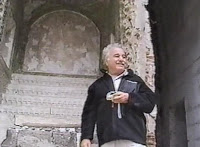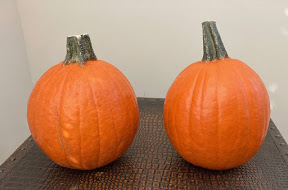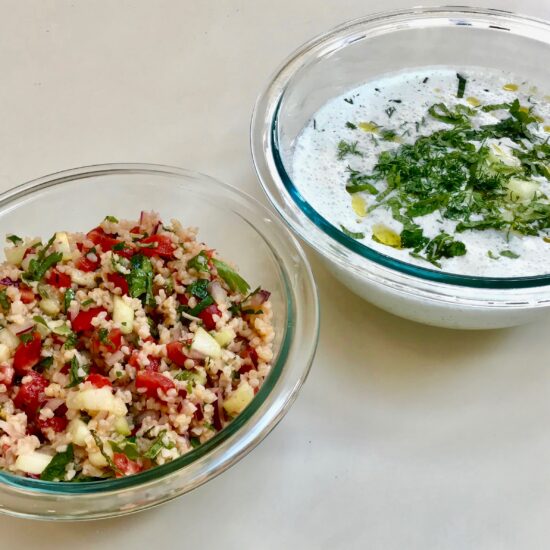For many of us in America, lahmajoun is our go-to model of Armenian food.
We love basturma, we devour pilaf, we argue about the thousand-and-one ways to marinate lamb. But when it comes to time to show off our favorite cuisine to odars (non-Armenians), we pop a few “Armenian pizzas” in the oven.
When it’s done right, the crust is soft enough to fold but still crunchy around the edges. The meat mixture picks up heat from the seasonings and sweetness from the chopped peppers. Add a squeeze of lemon for a bit of tang, then double the fun by sprinkling on the traditional mix of parsley
and onion slices.
No plates or utensils are necessary. Just wrap it up and chew. It’s all the good stuff quite literally rolled into one, which is why everyone loves lahmajun.
Who knew that would turn out to be a problem of international proportions?
Our friend Lucine Kasbarian recently alerted us to news reports that lahmajoun’s growing popularity has touched off the latest food fight between Armenia and Turkey.
Armenia, it turns out, has been promoting lahmajoun as a showcase delight from our national cuisine. Turkish television reacted indignantly when lahmajoun turned up on a couple of restaurant menus in Russia labeled as an Armenian specialty.
Turkey insists that lahmacun (Turkish spelling) is a Turkish creation. Several regions in Turkey claim its origin, including Gaziantep and Sanliurfa. Armenians have as much trouble swallowing that explanation as they do in recognizing the modernized names of Aintab and Urfa.
We could settle this now by simply declaring that lahmajun is Armenian, but that might be considered poor table manners by many of our friends
and neighbors.
The book Armenian Food: Fact, Fiction and Folk Lore notes that lahmajoun was introduced to present-day Armenia (where it’s called lahmajo) in the 1960s by repatriates from Aleppo, Syria. We can presume their families brought the tradition to Syria as survivors from Dikranagerd and other cities in Western Armenia but we can’t be sure.
We do know that variations on lahmajoun are popular not only among Syrians but Lebanese, who call it lahm bi ajin. The name suggests Arabic origins: lahm (meat) and ayin (bread). (Thanks to scholar Vartan Matiossian for adding that footnote to the original story from Al-Monitor.)
Where does that leave us? It would be accurate to say it leaves me hungry for lahmajun. But that’s a bit too flip considering the serious implications of this controversy, as well as its historical context.
The common ingredients and similar names of so many dishes from the Balkans to the Middle East have long provoked curiosity as well as arguments among devotees. In recent years, those disputes have turned serious as various countries have sought legal validation for their claims.
There’s huge money at stake in Greece’s claim to feta cheese, for example, or the dispute between Lebanon and Israel over hummus. For Armenians, the stakes are often more emotional than financial—especially when the challenge comes from Turkey.
Consider that lahmajun may well have been created in an oven in Urfa, but that doesn’t mean it wasn’t an Armenian’s oven. Who could prove it now? The historic Armenian quarter of Urfa was reduced to rubble by German artillery under Ottoman command in 1915. The Armenians who lived there were destroyed along with their homes and hearths.
Lost culinary lore might seem a minor dimension of the Armenian Genocide, but it’s just one aspect of the immense cultural devastation that Armenians continue to suffer from. Survivors often escaped with little
more than memories and the memories of their familiar foods were among the most valuable.
Regardless of who invented lahmajoun, it was important to the Armenians who made the journey to and from Aleppo. I’ll remember them, and thank them, the next time I eat it.





Lahmajoun! Thanks for the memory of getting that constantly at my grandparents house. I remember them using tortillas for the bread and making the mix. They tried to teach my sister and I how to make it once, and I put the mix on too thick, and I remember my grandfather taking A LOT of it off! Good stuff!
Based on the fact that the Kingdom of Armenia was around for over 5 thousand years and there was no such thing of a turk or turkey, and based on the fact that they took our culture over centuries as their own and then killed us off after stealing everything from us, I believe that our recipies are our own and the turks just did what they always have and stolen and plaigerized our foods, music, art and took our businesses, homes, farms, copper mines etc.and gave them to their military families to absorb as if they were the original owners. The turks dont have a cuisine or culture, they were mongol tribal barbarians and our foods didnt exist where they came from. They took from us and the greeks plain and simple.
This is exactly why they are so very desperate to cover the truth, because they'd have to admit to their brainwashed people that they stole everything from the original inhabitants of that land, the Armenian people and, that they are mixed Armenian blood. How many ottoman miltary men and families had Armenian women as their cooks and forced them into marriages as well. This is historical fact. Turkey is not it's own nation. It would be the same if China took over North America and then renamed all of our foods, inventions, music and culture Chinese and denied we ever existed.
I’ve seen several recipes for lahmajoun on this site and people struggle to find a good base for the topping using even Mexican tortillas! A simple, very easy bread base is to buy Pillsbury buttermilk Grands. Just roll each biscuit out to about a 6″ diameter and spread the topping. You’ll probably need some corn starch or Wondra flour to prevent the biscuits from sticking to the rolling pin. Cooks in about 9-10 minutes at 425º with the meat mixture on top.
My mother used to make them this way. My grandmother made her own dough.
We just made 2-1/2 dozen in short order.
Thanks, Bruce! Yes, that’s a pretty good alternative; enjoy your lahmajoun!